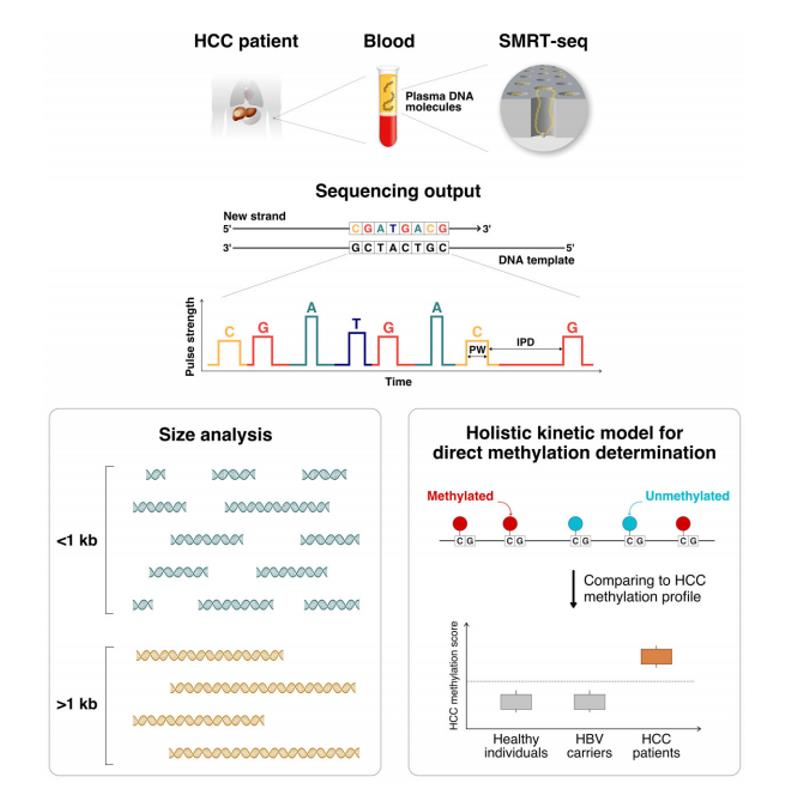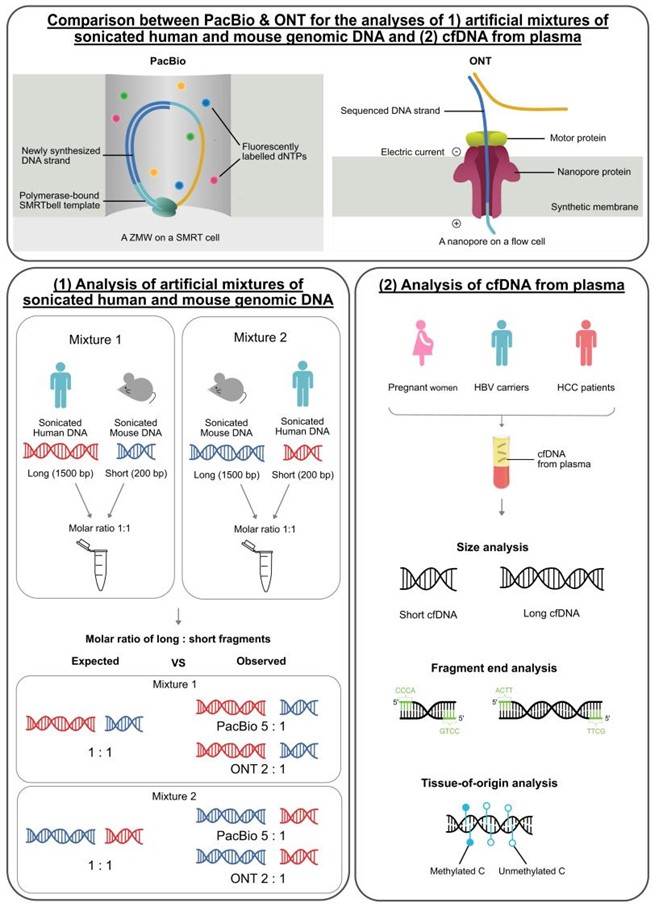We use cookies to understand how you use our site and to improve the overall user experience. This includes personalizing content and advertising. Read our Privacy Policy


We are dedicated to providing outstanding customer service and being reachable at all times.
Single-Molecule Real-Time Sequencing in cfDNA Analysis
At a glance:
- Overview
- Advantages of SMRT Sequencing in cfDNA Analysis
- Case 1: SMRT Sequencing Enables cfDNA Detection and Direct Methylation Analysis in Cancer Research
- Case 2: Comparison of SMRT Sequencing and Nanopore Sequencing for cfDNA Analysis
Overview
Circulating free DNA (cfDNA) refers to fragmented DNA molecules that cells release into the bloodstream. These fragments typically range in length from 50 to 300 base pairs and are present in the blood at relatively low concentrations. Circulating tumor DNA (ctDNA) serves as a nucleic acid biomarker employed for the detection and monitoring of cancer progression over time.
PacBio Single-molecule real-time sequencing technology has significantly advanced the field of genomics by allowing direct sequencing of individual DNA molecules without the need for PCR amplification or cloning. This technology has also been applied to analyze circulating free DNA (cfDNA), offering unique advantages in studying cfDNA fragmentation patterns, which can be informative for cancer detection and other diagnostic applications.
In traditional sequencing methods, DNA is usually fragmented and amplified before sequencing, which can introduce biases and artifacts. However, single-molecule sequencing directly analyzes the cfDNA molecules in their native state, providing more accurate information about their size distribution and fragmentation patterns.
Advantages of SMRT Sequencing in cfDNA Analysis
Some key advantages of using single-molecule sequencing technology for cfDNA analysis are:
- Accurate Fragment Size Profiling: Single molecule sequencing allows precise measurement of cfDNA fragment sizes without the need for amplification, enabling the identification of characteristic fragment size patterns associated with tumor-derived cfDNA.
- Identification of Nucleosome Footprints: Nucleosomes are repeating units of DNA wrapped around histone proteins. The organization of nucleosomes on cfDNA can provide valuable information about the tissue of origin and can aid in distinguishing tumor-derived cfDNA from non-tumor cfDNA.
- Detection of Terminal Motifs and Serrated Ends: Single molecule sequencing can capture and analyze the ends of cfDNA fragments, identifying specific terminal motifs and serrated ends that may be indicative of tumor-specific cfDNA.
- High Sensitivity for Cancer Detection: The ability to detect and analyze short cfDNA molecules through single molecule sequencing can improve the sensitivity of cancer detection, as cancer-derived cfDNA fragments tend to be shorter than background cfDNA from healthy cells.
- Potential for In Vitro and Computerized Analysis: With the discovery of new molecular features in cfDNA through single molecule sequencing, there is a possibility of developing improved diagnostic approaches, either through in vitro laboratory analysis or computerized data analysis.
Case 1: SMRT Sequencing Enables cfDNA Detection and Direct Methylation Analysis in Cancer Research
Research Background: The analysis of circulating cell-free DNA (cfDNA) has become increasingly important in cancer therapy. However, previous studies have mostly focused on short cfDNA fragments, and conventional bisulfite sequencing techniques can lead to DNA degradation, making it challenging to assess long DNA properties and methylation patterns accurately. This study aimed to address these limitations by employing single-molecule sequencing technologies, such as Single Molecule Real-Time (SMRT) sequencing, to detect longer cfDNA molecules and directly analyze their methylation patterns. The researchers aimed to develop a new indicator, the HCC methylation score, for cancer detection, specifically focusing on cancers other than hepatocellular carcinoma (HCC).
Methods: The study used PacBio SMRT sequencing to sequence plasma DNA from cancer patients. Each cfDNA molecule's fragment size and methylation pattern were analyzed individually through single-molecule sequencing, allowing the researchers to establish the HCC methylation score for cancer detection. To determine the contribution of plasma DNA from the liver, a scoring system was developed, evaluating specific methylation patterns of plasma DNA molecules relative to other tissues like buffy coat, lungs, or colon tissue.
 cfDNA from the plasma of cancer patients were sequenced with single-molecule sequencing. (Choy et al., 2022)
cfDNA from the plasma of cancer patients were sequenced with single-molecule sequencing. (Choy et al., 2022)
Research Idea: The study aimed to analyze cfDNA molecules from cancer patients' plasma and identify long DNA molecules. The researchers conducted direct methylation analysis using polymerase kinetic features during single-molecule sequencing and developed the HCC methylation score to distinguish cancer patients from non-cancer individuals.
Findings: The researchers discovered that a substantial portion of plasma DNA in patients with hepatocellular carcinoma (HCC), hepatitis B virus carriers, and healthy individuals consisted of molecules longer than 1 kb, with the longest molecule being 39.8 kb. Tumor-free cfDNA was generally shorter than cfDNA from non-tumor sources. Tumor cfDNA exhibited lower methylation levels compared to non-tumor cfDNA. Using long DNA molecules significantly improved the accuracy of cancer detection compared to using short fragments alone. The identification of this previously unknown population of long cfDNAs in cancer patients could pave the way for new liquid biopsy-based diagnostics and single-molecule resolution analysis of tissue origin.
Study Conclusion: The study revealed the existence of a previously unrecognized population of long cfDNAs in cancer patients. Analyzing these molecules and their direct methylation patterns provides new opportunities for liquid biopsy-based cancer detection. The use of multiple CpG sites in long plasma DNA molecules demonstrated their potential in effectively distinguishing cancer patients from non-cancer individuals, offering new possibilities for long cfDNA-based cancer diagnosis. The researchers also suggested that future work might explore other single-molecule sequencing technologies, such as nanopore sequencing, for even more efficient detection of long cfDNA molecules.
Case 2: Comparison of SMRT Sequencing and Nanopore Sequencing for cfDNA Analysis
Research Background: This research paper investigates the use of single-molecule real-time (SMRT) sequencing for analyzing long cell-free DNA (cfDNA) in plasma. Previous studies have demonstrated the potential clinical applications of long cfDNA in pregnancy and cancer. However, the performance differences between various long-read sequencing platforms for long cfDNA analysis are not well understood. The researchers aim to compare two SMRT sequencing platforms, PacBio and ONT, to identify any analytical characteristics and biases specific to each technology that could impact the analysis, such as a bias towards longer or shorter cfDNA fragment sizes.
Methods: The authors compared two SMRT sequencing platforms, PacBio and ONT, using an artificial mixture of ultrasound-treated human and mouse genomic DNA fragments to assess the size bias of each platform. The study involved analyzing cfDNA samples from pregnant women at different trimesters, hepatitis B carriers, and hepatocellular carcinoma patients. The data analysis included evaluating size bias, comparing ending pattern profiles, and analyzing tissue of origin based on single molecule methylation patterns.
 Workflow of analysis of the size, end-motif, and tissue-of-origin of long cell-free DNA in plasma. (Yu et al., 2023)
Workflow of analysis of the size, end-motif, and tissue-of-origin of long cell-free DNA in plasma. (Yu et al., 2023)
Study Idea
- Sample Preparation: cfDNA was extracted from plasma samples of pregnant women at different stages of pregnancy, hepatitis B carriers, and hepatocellular carcinoma patients.
- Sequencing Platform: The researchers used two SMRT sequencing platforms, PacBio and ONT, for the analysis.
- Artificial Mixtures: Artificial mixtures of human and mouse DNA fragments were created to evaluate the size bias of each platform.
- Data Analysis: The team analyzed the data to assess size bias, compare ending pattern profiles, and determine the tissue of origin using single-molecule methylation patterns.
- Detection Methods: For PacBio data, a convolutional neural network-based model called Integral Dynamics Model was used for 5-methylcytosine detection. For ONT data, nanopolish version 0.13.2, a Markov model-based hidden tool, was used for 5-methylcytosine detection.
Findings
- Both PacBio and ONT platforms exhibited a bias for longer DNA fragments, with PacBio showing a stronger bias, resulting in a 5-fold overrepresentation of longer fragments compared to a 2-fold overrepresentation for ONT.
- The percentage of cfDNA fragments longer than 500 bp was approximately 6-fold higher in PacBio compared to ONT.
- Terminal motif profiles of cfDNA from PacBio and ONT were similar but showed platform-dependent patterns.
- Tissue-of-origin analysis based on single-molecule methylation patterns showed comparable performance on both platforms.
Study Conclusions
SMRT sequencing, in general, generated a higher percentage of long cfDNA compared to nanopore sequencing (ONT). PacBio showed a stronger bias towards analyzing longer DNA fragments compared to ONT, though both platforms were biased towards longer fragments. Terminal motif profiles of cfDNA were similar between the two platforms but exhibited platform-dependent patterns. Tissue-of-origin analysis based on single-molecule methylation patterns performed similarly on both platforms. Researchers using PacBio and ONT for cfDNA analysis should be aware of possible analytical characteristics and biases specific to each technique.
Overall, this study provides valuable insights into the performance of PacBio and ONT platforms for analyzing long cfDNA in plasma samples from pregnant women at different trimesters and patients with hepatitis B carriers or hepatocellular carcinoma. The findings highlight the importance of considering platform-specific biases and analytical characteristics during cfDNA analysis.
References
- Choy, LY Lois, et al. "Single-molecule sequencing enables long cell-free DNA detection and direct methylation analysis for cancer patients." Clinical Chemistry 68.9 (2022): 1151-1163.
- Yu, Stephanie CY, et al. "Comparison of single molecule, real-time sequencing and nanopore sequencing for analysis of the size, end-motif, and tissue-of-origin of long cell-free DNA in plasma." Clinical Chemistry 69.2 (2023): 168-179.
Related Services
PacBio SMRT Sequencing
Oxford Nanopore Sequencing
For research purposes only, not intended for personal diagnosis, clinical testing, or health assessment

